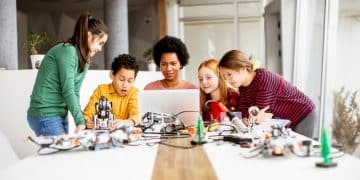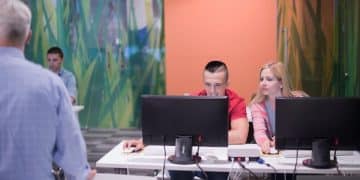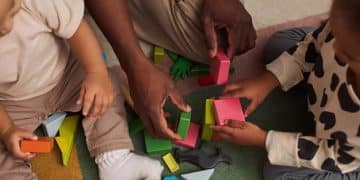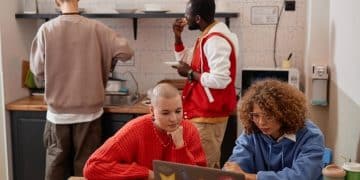Adapting Classrooms: New Approaches to Curriculum Development in US Schools
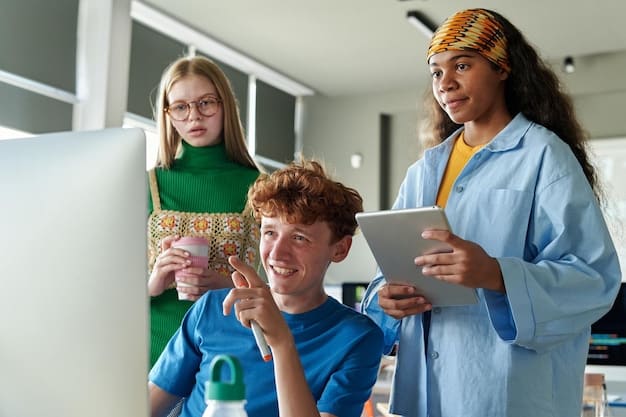
New approaches to curriculum development focus on personalized learning, technology integration, and real-world relevance, ensuring US schools meet the diverse needs of today’s students and prepare them for future challenges.
In the ever-evolving landscape of education, new approaches to curriculum development are essential for schools to effectively meet the diverse and changing needs of their students. US schools are increasingly adapting to incorporate innovative teaching methods, updated resources, and more personalized learning experiences.
Understanding the Need for Innovative Curriculum Development
Traditional curriculum models often fall short in engaging students who have diverse learning styles, backgrounds, and interests. To bridge this gap, innovative curriculum development is crucial in transforming education into a dynamic and inclusive experience. In addition, these approaches equip students with the skills necessary to succeed in an increasingly complex and competitive world.
The necessity for updated educational strategies is driven by multiple factors. Rapid technological advancements call for curriculums that incorporate and teach digital literacy, while evolving societal demands require an emphasis on critical thinking, problem-solving, and collaboration. In summary, innovative curriculum development focuses on adapting to these changes to deliver a more relevant and effective educational experience.
The Impact of Technology on Curriculum Design
Technology now plays a pivotal role in modern education. Curricula must integrate digital tools to facilitate engaging and effective learning environments. This includes using educational software, interactive simulations, and online resources to enhance understanding and retention.
Addressing Diverse Learning Needs
Every student learns differently, and a one-size-fits-all curriculum rarely works. Modern approaches emphasize personalized learning strategies, which cater to individual learning styles and paces. This involves tailoring educational content and methods to meet each student’s unique needs.
- Personalized learning plans designed to suit individual student needs.
- Adaptive learning technologies that adjust to student performance in real-time.
- Differentiated instruction strategies to cater to varied learning styles.
In conclusion, the move towards innovative curriculum development addresses the shortcomings of traditional models, ensuring education remains relevant, engaging, and effective in preparing students for future challenges. By embracing these approaches, schools can create learning environments that are truly student-centered.
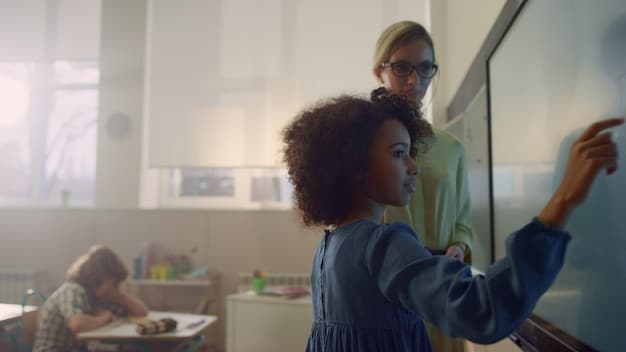
Personalized Learning: Tailoring Education to the Individual
Personalized learning is one of the most impactful new approaches to curriculum development. It shifts the focus from standardized instruction to customized educational paths that align with each student’s unique abilities and interests. This approach fosters greater engagement, deeper understanding, and improved academic outcomes.
At the heart of personalized learning is the recognition that students learn at different paces and in different ways. Therefore, educators design customized learning plans that consider each student’s strengths, weaknesses, and preferences. This involves continuous assessment and feedback to adjust the curriculum in real-time, ensuring that students are constantly challenged and supported.
Strategies for Implementing Personalized Learning
Implementing personalized learning requires a multifaceted approach that involves changes to instructional methods, assessment practices, and the use of technology. Teachers must be equipped with the tools and training necessary to create and manage personalized learning environments effectively.
The Role of Data in Personalized Learning
Data plays a crucial role in informing personalized learning strategies. Educators use data from assessments, observations, and student feedback to understand individual learning patterns and adjust instruction accordingly. This data-driven approach ensures that personalized learning plans are grounded in evidence and continuously refined.
- Regular assessments to monitor student progress and identify areas needing support.
- Utilizing learning analytics to gain insights into student engagement and performance.
- Feedback loops that involve students in the design and modification of their learning plans.
In summary, personalized learning represents a transformative shift in education, empowering students to take ownership of their learning journeys. By tailoring education to the individual, schools can create more engaging, effective, and equitable learning environments that prepare students for future success.
Integrating Technology Seamlessly
Technology integration is revolutionizing how curriculums are designed and delivered. As digital tools become more accessible and sophisticated, they offer unprecedented opportunities to enhance teaching and learning. Consequently, curriculums must leverage technology effectively to meet the demands of the digital age.
Effective technology integration goes beyond simply using devices in the classroom. It encompasses the strategic application of digital resources to support instructional goals, promote student engagement, and develop essential 21st-century skills. This can involve using educational software, online learning platforms, virtual reality simulations, and other innovative tools.
Best Practices for Technology Integration
Successful technology integration requires careful planning and execution. Teachers should thoughtfully select and incorporate digital tools that align with learning objectives and pedagogical principles. Professional development is also crucial to ensure that educators are equipped to use technology effectively.
Overcoming Challenges in Technology Integration
While technology offers numerous benefits, there are also challenges to consider. These include ensuring equitable access to technology, addressing digital literacy gaps, and managing distractions. Schools must proactively address these challenges to ensure that technology integration enhances learning for all students.
- Providing equal access to devices and internet connectivity for all students.
- Offering training and support to teachers and students to enhance digital literacy.
- Establishing clear guidelines for technology use to minimize distractions and promote responsible digital citizenship.
In conclusion, seamless technology integration is an essential component of modern curriculum development. By leveraging digital tools effectively, schools can create more engaging, interactive, and personalized learning environment, preparing students for success in an increasingly digital world.
Project-Based Learning: Connecting Curriculum to Real-World Applications
Project-based learning (PBL) is a dynamic teaching approach that engages students in real-world projects to apply their knowledge and skills. By emphasizing hands-on experiences and collaborative problem-solving, PBL fosters deeper understanding and prepares students for future challenges.
Unlike traditional methods that focus on rote memorization, PBL requires students to actively explore complex questions or problems over an extended period. Throughout the project, students conduct research, collaborate with peers, and present their findings, developing critical thinking, communication, and teamwork skills.
Benefits of Project-Based Learning
PBL offers numerous benefits for students, including increased engagement, improved academic performance, and the development of essential 21st-century skills. By connecting learning to real-world applications, PBL makes education more relevant and meaningful for students.
Implementing Effective Project-Based Learning
Successful PBL implementation requires careful planning and facilitation. Teachers must design projects that align with curriculum standards and engage students in meaningful inquiry. They also need to provide guidance and support throughout the project process, fostering student autonomy and collaboration.
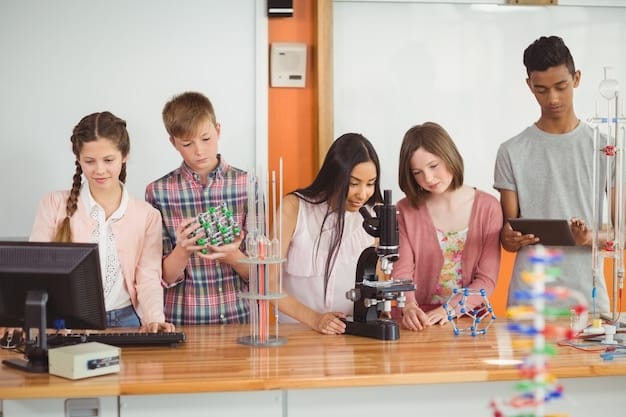
- Clearly defined learning objectives and assessment criteria.
- Opportunities for student choice and autonomy in project design.
- Regular feedback and reflection throughout the project process.
In summary, project-based learning represents a transformative approach to education, empowering students to become active learners and problem-solvers. By connecting curriculum to real-world applications, PBL makes education more engaging, relevant, and effective in preparing students for future success.
Focusing on Social and Emotional Learning (SEL)
Social and emotional learning (SEL) is gaining recognition as a crucial component of comprehensive curriculum development. SEL focuses on developing students’ self-awareness, self-management, social awareness, relationship skills, and responsible decision-making abilities.
Integrating SEL into the curriculum promotes a supportive and inclusive learning environment. Students learn how to manage their emotions, understand others’ perspectives, build positive relationships, and make ethical choices. These skills are essential for academic success, personal well-being, and positive contributions to society.
Strategies for Integrating SEL
There are various strategies for integrating SEL into the curriculum, including explicit instruction, modeling, and integration within academic subjects. Schools can also create a positive school climate that supports SEL through policies, practices, and activities.
The Impact of SEL on Student Outcomes
Research consistently shows that SEL has a positive impact on student outcomes, including improved academic performance, reduced behavioral problems, and enhanced mental health. By fostering social and emotional skills, schools can create a more supportive and effective learning environment for all students.
- Implementing evidence-based SEL programs and curricula.
- Providing professional development for teachers on SEL strategies.
- Creating a school-wide culture that values and promotes social and emotional well-being.
In conclusion, focusing on social and emotional learning is an essential aspect of modern curriculum development. By fostering social and emotional skills, schools can create more supportive, inclusive, and effective learning environments that prepare students for success in all areas of life.
Emphasizing Critical Thinking and Problem-Solving Skills
In today’s rapidly changing world, critical thinking and problem-solving skills are more important than ever. Curricula must prioritize the development of these skills to equip students with the ability to analyze information, evaluate arguments, and solve complex problems effectively.
Traditional curriculum often focuses on rote memorization and passive learning, which does not adequately prepare students for the challenges they will face in the real world. Emphasizing critical thinking and problem-solving requires a shift towards more active and inquiry-based learning approaches.
Methods for Fostering Critical Thinking
There are several methods for fostering critical thinking in the classroom, including questioning strategies, debates, case studies, and problem-based learning activities. Teachers can also encourage students to challenge assumptions, evaluate evidence, and consider multiple perspectives.
Assessing Critical Thinking and Problem-Solving
Assessing critical thinking and problem-solving skills requires more than traditional tests and quizzes. Educators can use performance-based assessments, portfolios, and rubrics to evaluate students’ abilities to analyze information, solve problems, and communicate their ideas effectively.
- Implementing inquiry-based learning activities that encourage student exploration and discovery.
- Using questioning strategies to prompt critical thinking and analysis.
- Providing opportunities for students to engage in debates and discussions.
In summary, emphasizing critical thinking and problem-solving skills is crucial for preparing students for success in the 21st century. By incorporating these skills into the curriculum, schools can empower students to become lifelong learners and effective problem-solvers.
Continuous Assessment and Feedback Processes
Continuous assessment and feedback are essential components of effective curriculum development. Regular assessment allows educators to monitor student progress, identify areas needing improvement, and adjust instruction accordingly. Feedback provides students with valuable information about their strengths and weaknesses, motivating them to learn and improve.
Traditional assessment often relies on infrequent, high-stakes tests that provide limited information about student learning. In contrast, continuous assessment involves ongoing monitoring of student progress through a variety of methods, including formative assessments, observations, and self-reflection.
Strategies for Implementing Continuous Assessment
There are several strategies for implementing continuous assessment in the classroom, including using exit tickets, quick quizzes, and peer assessments. Teachers can also provide regular feedback to students through written comments, conferences, and online platforms.
The Role of Feedback in Student Learning
Feedback plays a crucial role in student learning. Effective feedback should be timely, specific, and actionable. It should also focus on student effort and progress, rather than simply assigning grades. By providing high-quality feedback, educators can motivate students to learn and improve.
- Using formative assessments to monitor student progress and inform instruction.
- Providing timely and specific feedback to students.
- Encouraging students to reflect on their learning and set goals for improvement.
In conclusion, continuous assessment and feedback are essential for effective curriculum development. By regularly monitoring student progress and providing high-quality feedback, schools can create more responsive and effective learning environments that promote student success.
| Key Aspect | Brief Description |
|---|---|
| 🎯 Personalized Learning | Tailoring education to meet individual student needs and interests. |
| 💻 Tech Integration | Seamlessly incorporating digital tools to enhance teaching and learning. |
| 🤝 Project-Based Learning | Engaging students in real-world projects that apply their knowledge. |
| 🧘 SEL Focus | Integrating social and emotional learning to support student well-being. |
Frequently Asked Questions
▼
Personalized learning tailors education to each student’s unique needs, skills and interests, allowing for a more engaging and effective learning experience. It values flexibility and individual pacing.
▼
Technology integration enhances the curriculum by providing interactive learning tools, access to vast resources, and fostering collaboration between students and teachers. It makes learning more dynamic.
▼
Project-based learning fosters critical thinking, problem-solving, and collaboration skills. It also makes learning more relevant by connecting classroom lessons to real-world applications, enhancing engagement.
▼
Social and emotional learning is essential for developing students’ emotional intelligence, empathy, and relationship skills. It creates a positive school climate and supports mental health and academic achievement.
▼
Continuous assessment provides ongoing insights into student progress, allowing teachers to promptly adjust their teaching methods. Students also benefit from regular feedback, promoting growth and improvement.
Conclusion
As US schools continue to evolve, embracing new approaches to curriculum development is vital. By focusing on personalized learning, technology integration, project-based learning, social and emotional learning, and continuous assessment, educators can create more engaging, effective, and equitable learning environments that prepare students for success in an increasingly complex world.
